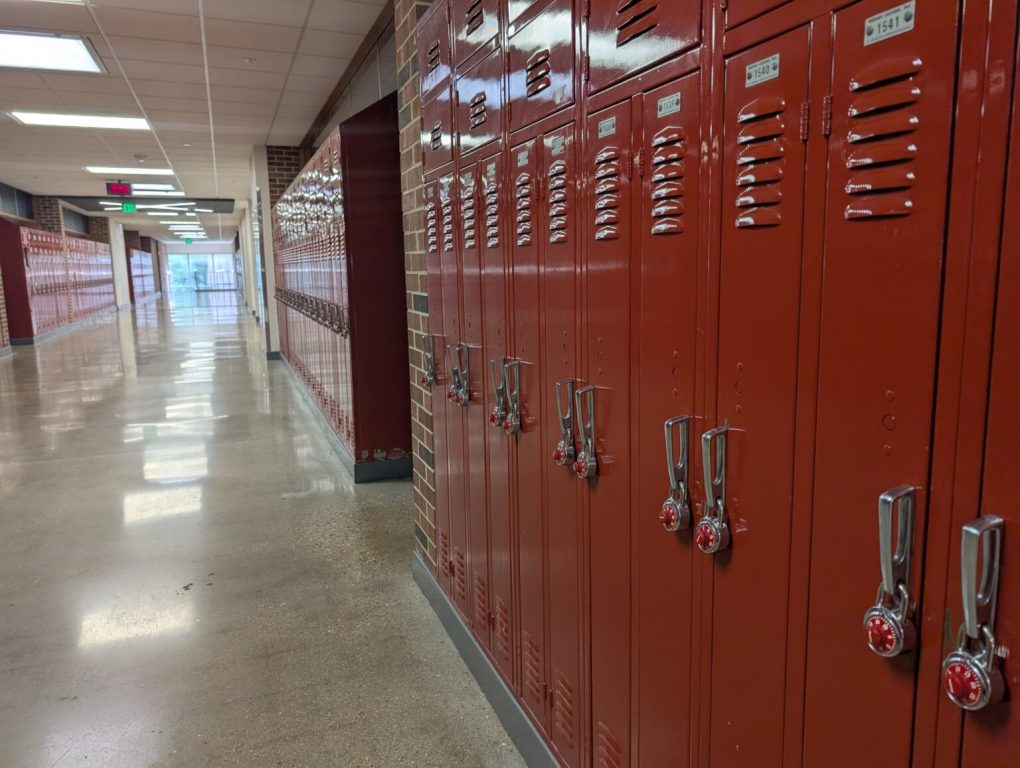Estimating Failure Results in Special Education Aid Falling Short of Touted Record Level
Result could be more school district referendums.

DPI announced this week that initial special education payments would reimburse schools for their special education costs at 35%. A hallway in La Follette High School in Madison. (Wisconsin Examiner photo)
Initial special education reimbursement payments to school districts this year will be about 35% of their costs — about 7 percentage points below the estimated rate approved in the state budget.
When the 2025-27 state budget was passed by the state Legislature and signed by Gov. Tony Evers in July, policymakers boasted that their investments would bring the special education reimbursement rate to a historic 42% in the first year of the budget and 45% in the second year.
While school districts will still receive more aid for special education costs this year than in previous state budgets, it appears that the state funding set aside probably won’t be enough to reach the rate that was estimated when the budget was signed in July.
The Department of Public Instruction (DPI) announced in a bulletin on Monday that initial special education payments for November through March would reimburse schools 35% of their special education costs. While DPI uses a slightly lower rate to avoid overpayment and this is not the final reimbursement rate, Chris Bucher, DPI director of communications, said in an email that the agency has anticipated the rate falling below the estimate.
Special education reimbursement rates for public school districts can vary from the estimate because it is a sum certain allocation, meaning that payments come from a fixed pot of money.
During the budget process, public education advocates, DPI and Evers called for that to change to a sum sufficient allocation, meaning that the amount of money provided by the state would be enough to meet the set reimbursement rate. Republican lawmakers rejected the request.
Bucher said having a lower reimbursement rate than what is estimated has been relatively typical with budgets, given that there is a fixed amount of state funding as well as a rising amount of unaided special education costs and a rising number of students with disabilities.
According to a Legislative Fiscal Bureau memo released Thursday, in 2024-25 the state had appropriated about $574 million to special education aid. When the 2023-25 state budget was passed, the appropriation was estimated to bring schools to a 33.3% rate in each year of the budget. In November 2024, DPI estimated a rate of 29.16%, and the final rate for that school year was 30.64%.
Based on cost increases in recent years, DPI projected costs would grow by 4% for its 2025-27 state budget request. It had estimated that aidable costs would be about $1.8 billion in 2025-26 and $1.9 billion in 2026-27. Those estimates were also used as Evers prepared his budget request and as the Legislature prepared the budget.
According to the new memo, DPI now projects that aidable costs in 2024-25 increased by an estimated 9% — a rate more than twice the original projection when the 2025-27 budget was being drafted.
For the 2025-27 state budget, the DPI requested about $2 billion across the biennium to cover special education costs for school at a rate of 90% by the second year of the budget and to change the funding from “sum certain” to “sum sufficient.”
Evers also requested the change from sum certain to sum sufficient, though he requested increasing it to a 60% rate by the second year. The Joint Committee on Finance denied those requests instead choosing to provide $207 million in the first year of the budget to cover an estimated 42% of costs and $297 million in the second year to cover costs at an estimated rate of 45%.
Advocates called attention to the reimbursement rate in statements this week, saying the funding system needs an overhaul.
Peggy Wirtz-Olsen, president of the Wisconsin Education Association Council, the state’s largest teachers union, blamed the rate on lawmakers, saying that they “turned their backs on our most vulnerable children, failing to deliver on promised special education funding and leaving our students without the supports they need to succeed in school.”
“This shortfall will mean even more communities forced into holding school referendums in 2026 just to meet basic needs, causing uncertainty and hardship for students who deserve better from their elected leaders,” Wirtz-Olsen said in a statement.
Wirtz-Olsen said lawmakers have been “caught lying about the scant resources they are providing.”
“It’s time for these politicians to fix Wisconsin’s school funding formula and fulfill what the state Constitution requires,” she said. “Taxpayers have had enough of picking up the tab on our property taxes to make up for their refusal to fund schools. If they won’t take action for the students who most need help, educators and families will.”
Beth Swedeen, executive director of the Wisconsin Board for People with Developmental Disabilities, called on the state to change the way it funds school districts.
“It’s time to build a budget that is rooted in real costs and can provide budget certainty to schools and parents that the promises made by the legislature will translate into real dollars schools can use,” Swedeen said in a statement. “We should not be in this position cycle after cycle where students with disabilities and schools are undercut by accounting codes.”
Special education reimbursement payments to schools fall far below estimate was originally published by the Wisconsin Examiner.
If you think stories like this are important, become a member of Urban Milwaukee and help support real, independent journalism. Plus you get some cool added benefits.





















